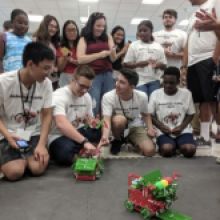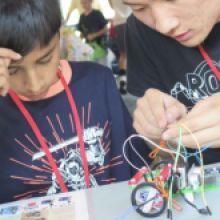As a child growing up in a small town in India with little access to electronics or technology, Anurag Purwar never had a chance to experience anything related to robotics.
“Looking back, I’m sure it would have had a major impact on me,” said Purwar, now an assistant professor of Mechanical Engineering in the College of Engineering and Applied Sciences at Stony Brook University.
And while a second chance at childhood is the stuff Hollywood screenplays are made of, Purwar is not only getting an opportunity to experience the dreams he missed, he’s working with a greater goal of making a transformational robotics experience possible for today’s children all around the world.
Boosting his noble cause, Purwar’s research group, in collaboration with Stony Brook University startup Mechanismic Inc., recently received a $1 million award from the National Science Foundation (NSF) for their proposal, “A Design-Driven Educational Robotics Framework.” The award comes from NSF’s Small Business Innovation Research/Small Business Technology Transfer (SBIR/STTR), an approximately $180 million seed funding program designed to help commercialize high-risk technological innovations via research and development grants to small businesses and startups.
Assisting Purwar with their own unique expertise are Stony Brook colleagues Keith Sheppard from the Institute of STEM Education, Erik Flynn, clinical lecturer from the School of Health Technology and Management, Kedar Kirane, assistant professor, Department of Mechanical Engineering, and Jeff Ge, professor and chair, Department of Mechanical Engineering.
The award follows Phase I funding Purwar received from the NSF in 2019, which led to the development of SnappyXO Design, a platform that was conceived and developed in Purwar’s research lab, Computer-Aided Design and Innovation. Prior to receiving NSF funding, Purwar received funding from the NSF’s I-Corps (Innovation-Corps) program, which helped him with customer discovery. Building upon his entrepreneurial experiences, Purwar is the current PI and the site director of the NSF I-Corps program at Stony Brook.
Mechanismic Inc. is the licensing partner and is working to bring the technology to market. The company, for which Purwar serves as CEO, has received several startup awards and grants from the SUNY Research Foundation, Fuzehub, SPIR, SensorCAT, and MTRC (Manufacturing & Technology Resource Consortium at Stony Brook programs. In addition, Purwar and his team have received significant commercialization support from SUNY Research Foundation as a SUNY Technology Accelerator Fund (TAF) awardee and SUNY Startup Summer School Class of 2020 graduate and TAF Catalyst Investment winner.
“SnappyXO was originally created to address a fundamental need to teach freshman college students authentic engineering design in the context of robotics,” he said.
Purwar is currently working to develop a Design-Driven Educational Robotics Framework, a unified and holistic platform which teaches students engineering design, practical electronics, and computer programming under one umbrella, and brings a new approach to STEM and robotics education. In this model, students engage in the entire design innovation cycle from conceptualization to programmed robots.
Purwar said that this multi-disciplinary approach provides multiple entry points for students to be engaged in different STEM disciplines, including mechanical engineering, electrical engineering, and computer science, rather than just focusing on coding.
“This approach has been shown to be especially effective for engaging young women and encouraging them to pursue STEM education and careers,” he said. “Given that both minorities and women are highly underrepresented across STEM education and careers, adoption of this teaching style presents an opportunity to increase engagement among these groups.”
Purwar’s robotics education program is unique in that it enables students to not only build robots but to design and prototype their own robot kits. The incorporated hardware has varied levels of sophistication suitable for individual students’ level of knowledge.
“This technology can not only transform STEM and robotics education in schools and colleges, it could also lead to design tools used by automation and robotic industries,” he said.
“Professor Purwar and his SnappyXO robot kit have been featured in the summer MTRC Robotics Camp since 2018, in which high school students team up to learn and design robots for prescribed tasks,” said Imin Kao, executive director of MTRC. “This robotics learning program is a workforce development event for MTRC because these students will join the manufacturing workforce in just a few years.”
A key component of SnappyXO Design is a state-of-the-art robot motion design software, which builds on years of Purwar’s NSF-funded research in solving an age-old problem of kinematic design of machines and robots.
“As part of this project, our research is going to bring together rigid body kinematics and machine learning to develop a suite of methods and algorithms for an AI-driven mechanism design architecture,” he said. “This software will democratize design innovation and invention and put the power of creativity in the hands of every student and engineer. SnappyXO Design also comes with a patented hardware and standards-aligned curriculum for K-12 and college students.”
Purwar said this award will enable his research team to develop the next generation of hardware for robot design, software for building invention design capacity, and a standards-aligned curriculum for K-12 and college students.
“Creating this robotics education product is my way of reliving my childhood playing, tinkering, and learning with robots and machines that I wish I had,” he said. “I expect that the scalability and affordability of this product would allow millions of children all over the world to experience authentic robotics education.”
— Robert Emproto




